How To Create Mixtape Covers In Photoshop
They say to never judge a book by its cover, and while we'd like to think that the same goes for albums—it's the music on the inside that counts—there's something to be said for a well-designed album cover. It's your chance to catch the attention of new listeners and give a visual representation of the music within. A great album cover can inspire someone to fish your vinyl out of the stack, encourage a streaming listener to learn more about you, and add a whole new layer of artistry to your work.
Although having an original and expressive album cover design is important, the process itself doesn't have to be daunting. We've assembled a comprehensive guide to designing your album cover, from the early brainstorming stages to finding the design style that syncs perfectly with your music.
Contents
- Before you start your design process
- Go on an identity quest
- Find inspiration
- Key components of designing your cover
- Color
- Typography
- Imagery and style
- Don't forget the details
- Think big…and small
- Finding the right designer/artist
- What's next?
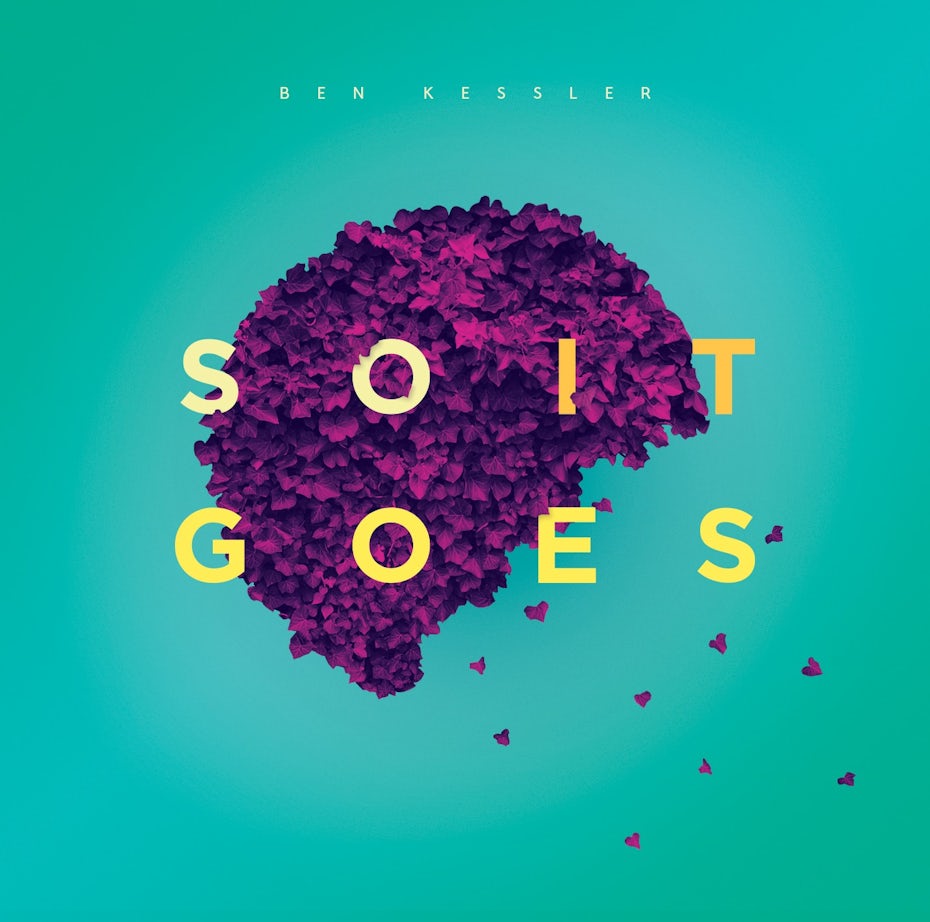
Before you start your design process
—
You might be tempted to immediately start sketching your vision for your album cover, but the first step in any design process should always be to take a few steps away from the design entirely. Instead of launching right into ideas for your cover, focus on doing a little identity quest first—it will help you later when it comes to thinking about design.
Go on an identity quest
1. Who are you?
You can get as existential with this one as you like, but really focus on who you are as an artist, band, musician, etc. How would you define yourself?
2. Who is your audience?
Before you jump to answer "everyone," think about this one a little more deeply. Who are you trying to reach with your songs? Who are the kinds of people standing in the front row of your show? While it's a great goal to reach everyone with your music, you likely have a slightly narrower audience. Figuring out who that is can help you cater your album design to their interests.
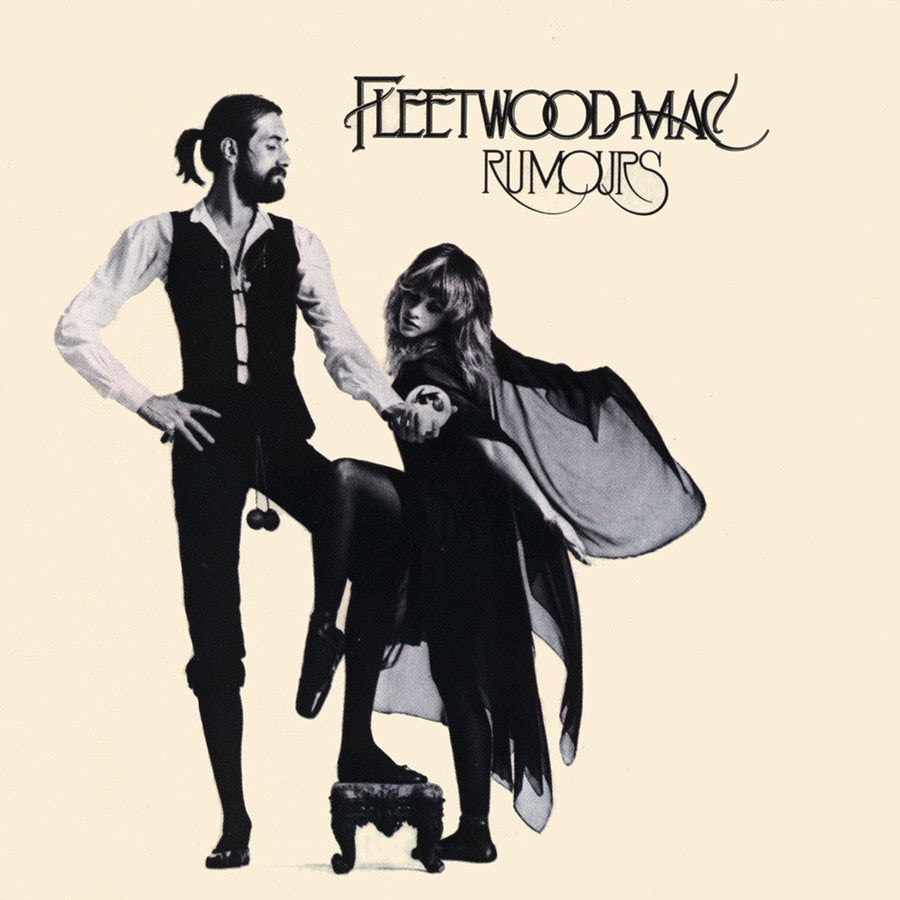
3. What do you want your listeners to feel when they hear your music?
Music can sometimes feel intangible—how could you describe it in words? But whenever someone makes music, they have an idea of how they want people to respond to it. Think about the emotions you want your listeners to have when they hear your album.
4. Elevator pitch your sound: what are the key words?
The elevator pitch is just as important for a band or artist as it is for the founder of a company—you should be able to succinctly describe what it is you do. So, if you're in an elevator with someone and you've got 30 seconds to describe what your music is like, what would you tell them?
Take notes
Take some notes from your identity question session. Write down the words that have the most meaning for you so that when it comes to thinking about design elements, you'll already have a good sense of what you're hoping to accomplish. Ultimately, your album cover is a way for you to express your band's identity—just like you do with your music—so it should be in line with your sound.
Find inspiration
As a musician, you know that inspiration is important. Music does not just occur out of nothing; it needs to be pulled from somewhere. When it comes to song writing, you may be inspired by an event, a piece of art, an image, a sound, a feeling, etc. You can think about designing your album cover in a similar way—what is inspiring that visual representation? Perhaps you'll think about the same inspirations that struck you in your song writing, effectively translating that musical inspiration into images.
In addition to thinking about the inspiration for your own work, it's always helpful to think about who you admire and draw ideas from their work. What are some album covers that you are drawn to? What do you like about them? Be sure to take some notes—combined with your identity notes, these will help you narrow your design process.
Key components of designing your cover
—

There are several elements that come into play for every album cover, from the colors and imagery used on the front cover to the typography and text on the back. Isolating each component will help you take things step by step, rather than getting overwhelmed with the whole design all at once.
Color
Color selection is an important aspect to all design, and the same is true of album covers. Even a black- or white-heavy album cover represents a thoughtful decision on color: it evokes a different feeling than a vibrant, multicolored cover, right? With so many colors to choose from in the spectrum, we've come up with a few different ways to help you identify what colors to use in your design.
Color psychology
There is a lot more to color than might meet the eye, and to learn more about color theory and how it is used in branding, be sure to check out this in-depth guide. But for now, the quick explanation is that colors can make us feel a certain way. They have emotional attachments, which is why companies often use specific colors in their logos or product packaging. The same can be applied to album covers, because as a musician, you want your audience to feel a certain way when they hear your music. The album cover—a visual representation of your music—allows you to enforce that feeling in another way. If, for example, you want your listeners to feel happy and playful when they listen to your music, you might want to lean into yellow and orange in your cover design. For more subdued and melancholy music, darker colors, especially dark blue and gray, will help set the tone in your album cover design.

Color scheme
If you've identified a color that you'd like to use in your album cover, you may want to stick with it throughout—if it worked for The Beatles with the White Album, it could work for you too—but you may not be looking for a minimalist, monochrome look for your cover. Fortunately, color theory also identifies complementary colors to help you select secondary and tertiary hues to go along with your dominant color.
Monochromatic basically means using all one color—but it can be one color in many shades to offer some more dimension. The overwhelming feeling of a monochrome cover is one of simplicity and minimalism. It can be selected to tap into a certain mood, or can be used as a way for the artist to have the music speak for itself. This can end up being a very bold choice.
You've probably seen a color wheel before, which is a great key into choosing colors that work well together. For complementary colors, the rule is, the color directly across from the color on the wheel is the most complementary—so if you've chosen yellow, violet would naturally correspond. Complementary colors bring out the best in each other, and can create dynamic visuals.
You can also go for analogous colors—colors that are close to each other on the wheel, so they naturally work in harmony. This gives you more dimension than monochrome colors, but they can still have a blending effect—they may not stand out as much as complementary colors.
Another option is picking triadic colors, which effectively draw from three equal sections on the color wheel. These tend to be more stimulating than analogous colors, but the color meanings may not mesh as well if you're trying to tap into color psychology.

In addition to working with the color schemes above, another choice a band or artist can make is to go for more anachronistic colors. Instead of adopting colors that work in harmony with one another, you can opt for stark combinations to elicit a different kind of feeling. It can suggest nonconformity, throwback to psychedelic inspiration, or simply shock the viewer. Take a look at the clashing colors in the Foes album design by JETARTS—it certainly makes you feel visually shocked when you look at it. Of course, you'll want to go back to your identity questions and think about what you want your listener to feel before adopting wild color combinations.
Typography
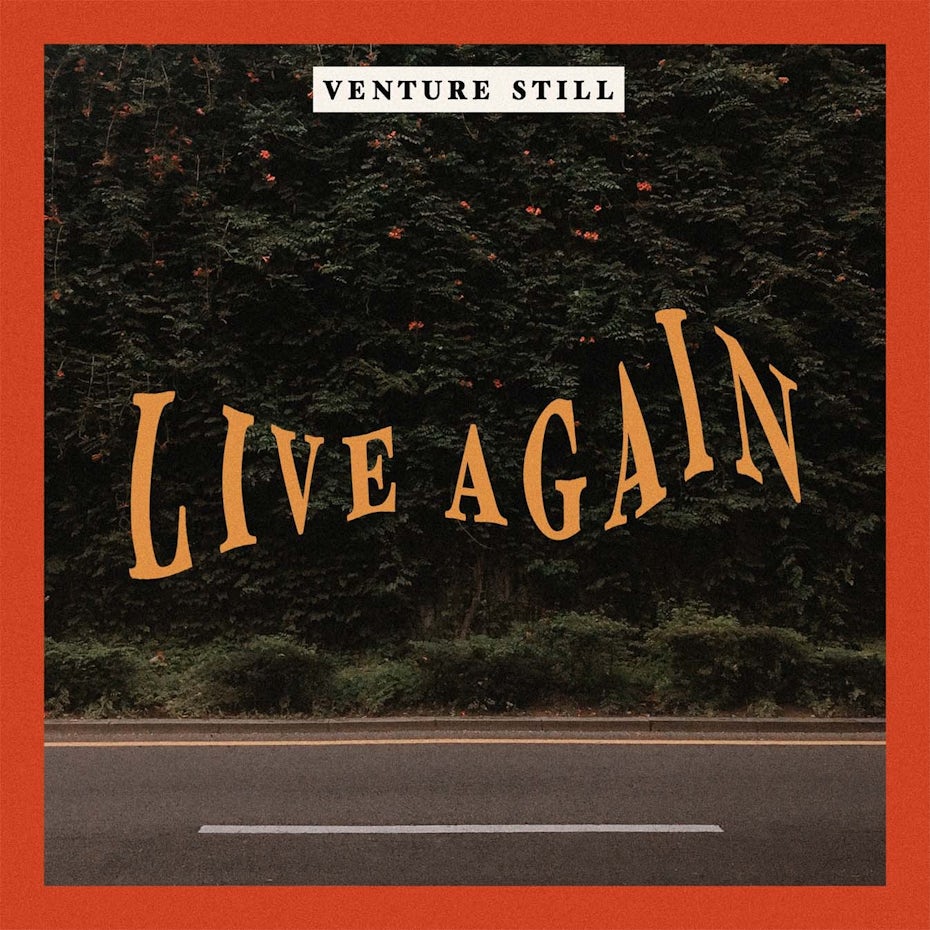
Just like colors, the fonts you choose for your album cover can help communicate your band's personality. It's also important to think about all of the different places you'll want typography—the album title and band name, track list on the back, and even the inner jacket, which is album cover adjacent.
Serif fonts are the old-standby when it comes to fonts. These are noted by their serifs—the little feet at the end of letters. Serif fonts are thought to be more serious and traditional, Times New Roman and Cambria are common examples. Serif fonts pair well with classical, acoustic or operatic music.
Sans serif fonts are fonts without serifs, meaning fonts without the little feet. Helvetica and Arial are commonly used sans serif fonts. These fonts are often considered more modern and streamlined than their serif predecessors. Sans serif fonts can be used with a variety of music, including electronic and indie rock—it's a versatile choice for modern music.
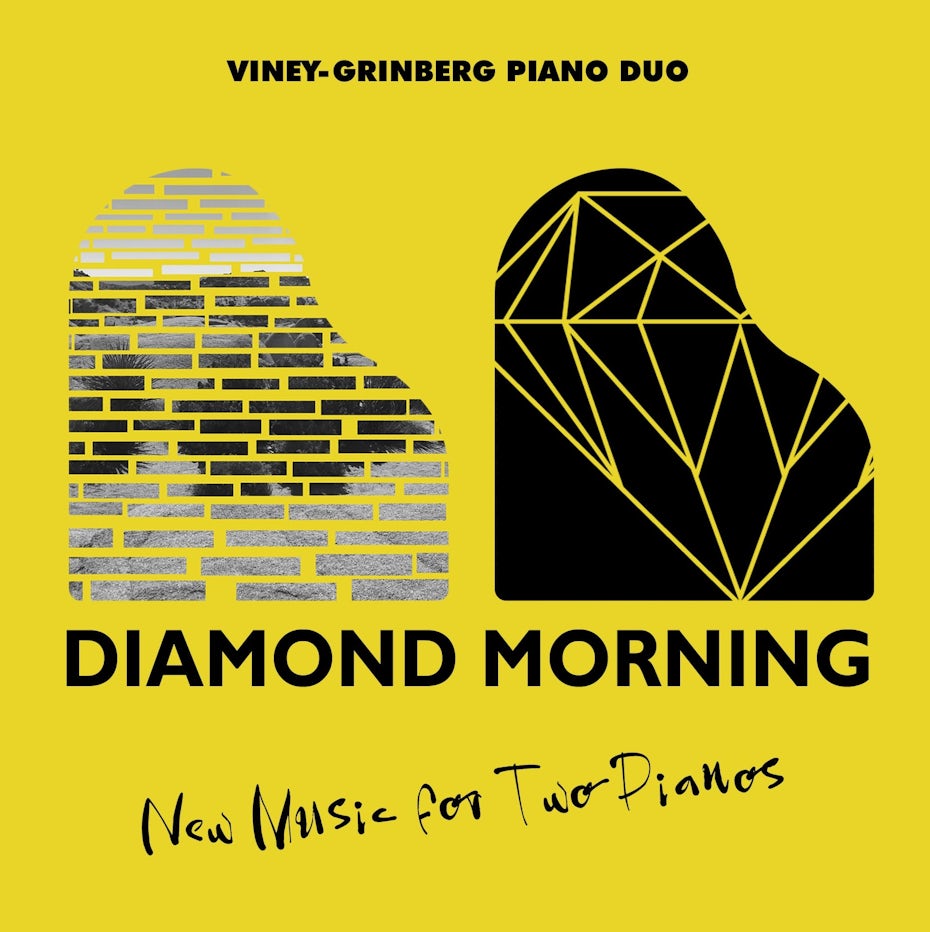
Script fonts are cursive fonts that emulate handwriting. These can range from very traditional and ornate to playful and even messy. The different styles of script fonts mean they can be used to invoke a variety of feelings. Script fonts are used for a broad range of music types—scratchy, messy fonts might be used with alternative rock, where a precise signature style might be used for a contemporary solo artist.
As the name suggests, display fonts are decorative and meant to display. They are also referred to as novelty fonts and can often be found on book covers or signage. Like script fonts, there is a range of styles for this type of font. Gothic display fonts are often featured on heavy metal album covers, and a playful, bubbly display font could be used for a children's music album.
Because you'll need to use text in different places on your album cover, you can use a combination of font styles. For example, you could opt for a script or display font for the album title and band name, and a more easily legible font for the track list and other pertinent information. The typography on the front of the cover can be more artistic than on the back, where readability is more important.
Imagery and style
After colors and typography, imagery is an important aspect to any album cover design. Musicians commonly utilize photography, especially of the band or primary artist, but almost anything is possible, from abstract graphics to drawings and collages.
We talked a bit about color psychology, and there's some psychology when it comes to images as well. Images of faces—whether a photograph or drawing—tend to jump out more than other pictures. If you're trying to catch the attention of a potential listener, using an image of a face—along with choosing the right colors and fonts—can help ensure that your cover gets noticed. Faces also convey expressions, which can reflect on the viewer's mood or feelings. This can help tie into the feelings you want your music to inspire in your listeners.
And an important, legal note: If you decided to use photography or artwork for your cover, be sure to have the image rights!
Any graphics that are used on an album should communicate with the album itself, so it's important to use them thoughtfully. A painted watercolor landscape might connect well with a mellow, instrumental album, but it would probably send a mixed signal if the album was EDM. Similarly, the choice to not include graphics should feel purposeful, and not like you just couldn't think of something to put on the cover.

Minimalism can also make a statement in album cover design. Going simple allows the focus to ultimately lie with the music within the album. Minimalism is an on-trend album design style though, so it's a good idea to try to stand out in a different way—perhaps you opt for an all-black cover, but instead of using white type, you opt for a colorful ombre.
Shown above, designer Creative Spirit took the simple graphic of a vintage microphone and cast it in a punchy salmon color, overlayed on mint green. Although it's undeniably minimalist, the designer's color choices make the cover feel more bold, while maintaining a balanced, simple design. For the cover design on the right, designer Edina plays with the album's title From Scratch and made scratch marks the focal point of the minimalist cover.
The overall style of your album cover is the combination of color, imagery, and typography. These three elements should work together in harmony to create the desired effect. Calling back to your identity questions and your inspiration, you should feel like your design is in line with that exercise.
Don't forget the details

When designing your album cover, it's okay to get swept away in the design—it can be really fun! But when you come down from your design buzz, be sure to remember the integral album components you need to include.
1. Band and album name
You don't have to include the band or album title on the front of your album cover, but it needs to be on the spine. Sometimes the album name or band name is the primary design element for the cover and in this case, the name has to stand out. A reason why there's currently a trend to not include names on the cover design is because people are now commonly listening via streaming services, where artist, title, and album name are all listed beside the cover thumbnail. So if graphics are important, you can free up some necessary design space by leaving names out of the picture. This is a great option for digital-only album releases.
2. Track list
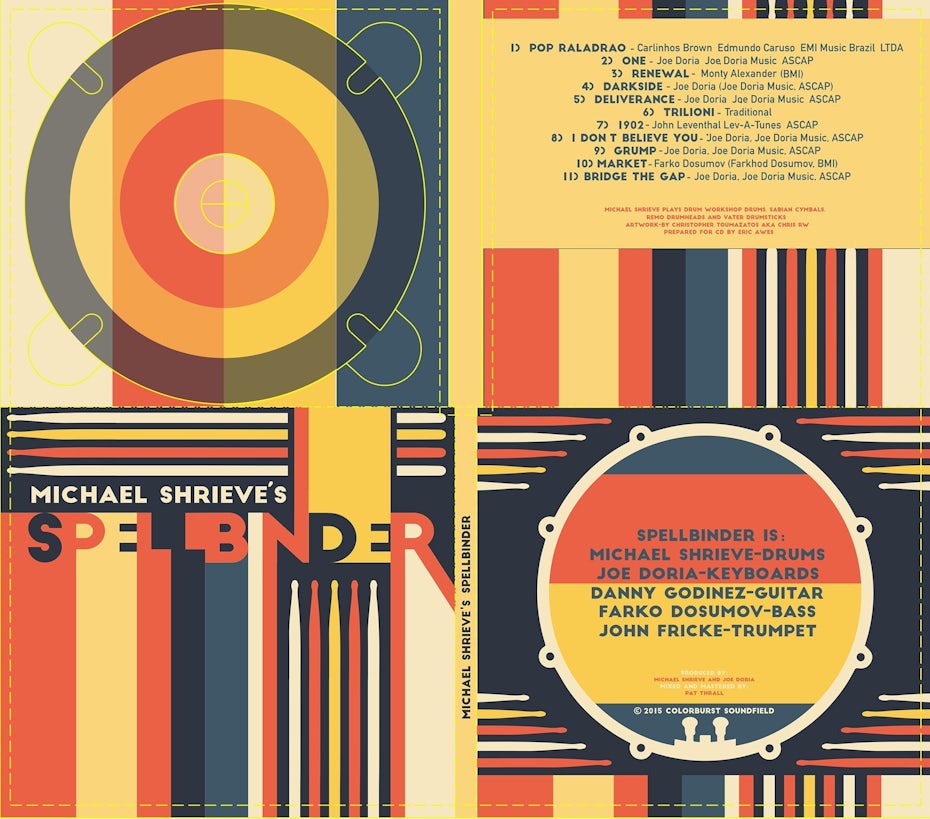
The back cover of the album should include the album's track list. Although the typography can be different here than on the front of the cover, it should still communicate stylistically and be easy to read at the same time.
3. Licensing and legal information
Be sure to have a space on the back cover or inside for all licensing and legal information.
4. Easy on the Internet
Resist your impulse to put social handles anywhere on your album cover. While Twitter, Instagram, and Facebook are used regularly today, who knows what will be the dominant social trends in 5, 10, or even 20 years. Using handles can unwillingly date your album. If you want to include your band's URL, do so on the back cover or liner note.
5. Liner note
While not technically part of the album cover, the inner jacket should be designed with thought to the style of the album cover—it should feel like an extension of the design. You'll want to use similar fonts for song lyrics and band information and choose a color scheme that communicates with the overarching design.
Think big… and small.

Designing an album cover in 2017 is not like it was in 1977. You need to think about multiple formats when considering your design. For example, if you're releasing vinyl, you need to think of what your design will look like in that size, as well as the size of a CD. You also need to consider how the cover will look as a thumbnail, as people will likely see it on iTunes, Spotify, Pandora, and other platforms. The image should not require squinting or illicit confusion from the viewer.
Finding the right designer
—
Having thought through your band's identity and all of the necessary style points for your album, you're ready to hire a designer! Although you may be wary of letting someone else take the reins of your album cover, a professional designer is not only super capable and experienced in illustration and graphics, but will also ensure that your ideas are brought to life in the best way. They'll know what's possible, what will look the best, and they're efficient and effective. While DIY has its place—say, a handmade Valentine?—investing in a well-designed cover will ensure you're putting out the best product.

Communication is key for both you and your prospective designer, so it's important to make sure you're accurately relaying your needs. If you're articulating what you're looking for, a professional designer will be able to realize it for you.
A potential designer red flag? Your designer seems more interested in their artwork than your vision. While it's helpful to have artistic feedback on your ideas, it's important that you do not let your project drift away from the core of what your music is all about. Rather, you should be working together to make sure you're creating a product you're happy with.
Originality is important. You'll share your inspirations with your designer, but you'll also want to stand out. So, be open to suggestions and make sure that your designer can draw from inspiration while creating something new and fresh.
A good way to get a design you feel good about is to launch a design contest. This will allow you to see different design options and provide feedback for what works for you.
What's next?
—
Once you have your album cover design complete, your album is ready to amaze your fans and captivate new listeners. Whether you're doing a digital-only release or a vinyl album, your album cover can help you draw in the crowd. Time to rock!
Looking for a professional album cover that is in tune with your music? Start your album cover contest today!
How To Create Mixtape Covers In Photoshop
Source: https://99designs.com/blog/design-other/how-to-design-album-cover/
Posted by: drakeimensid.blogspot.com

0 Response to "How To Create Mixtape Covers In Photoshop"
Post a Comment